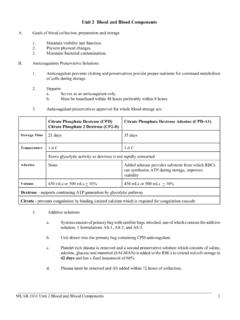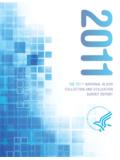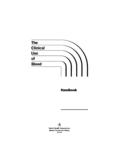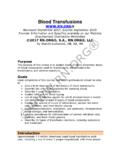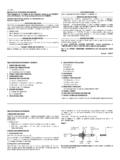Transcription of GENERAL NURSING POLICY AND PROCEDURE …
1 GENERAL NURSING POLICY AND PROCEDURE manual Page 1 of 13 Title: blood / blood Components, Type and Screen: Preparation and Administration of POLICY No. Joint Commission Chapter/Section: Effective Date: May 2014 Source ( document, award, or committee, etc.): K. Raska Jr., , , Chairman J. Toscano, MT(ASCP) SBB, blood Bank Supervisor R. Samson, MT(ASCP), Laboratory Director H. Veltre MS, RN, NURSING Director, Emergency Services S. Frame MS, RN-BC , Nurse Manager, Peds B. Adler, BSN, RNC-NIC, Clinical Educator - NICU Transfusion Committee Publication Status: New Revised X1985, 1987, 4/88, 3/90, 6/92, 7/92, 8/92, 4/93, 4/95, 4/97, 1/00, 2/01, 10/02, 6/04, 1/05, 6/06, 9/08, 10/08, 11/08, 12/09, 6/11, 5/12, 3/13 Reviewed Cross-Referenced POLICY No: Perioperative Autologous Transfusion , Patient Identification Administrative POLICY 950-23 Issuance of blood and blood products ( blood Bank POLICY manual )I.
2 POLICY : The following sections state the POLICY and PROCEDURE for blood component transfusion: A. GENERAL blood Product Transfusion PAGE 1 B. Obtaining a Specimen for Type and Screen PAGE 3 C. Before Obtaining blood from the blood Bank PAGE 5 D. Obtaining blood Products from the blood Bank PAGE 5 E. Obtaining blood Products Through the Pneumatic Tube System PAGE 6 F. manual or Cooler Pick-Up of blood Products PAGE 6 G. PROCEDURE for blood Administration (non-ICU) PAGE 8 H. Neonatal Intensive Care PROCEDURE for blood Administration PAGE 9 I. Emergency Issuance of Uncross-matched blood PAGE 11 J. Adverse Reaction PAGE 11 II. PURPOSE: To provide blood product transfusion to patients, per licensed independent practitioners order, in accordance with the New Jersey State Department of Health, College of American Pathologists, FDA and American Association of blood Banks (AABB) guidelines.
3 III. PROCEDURE : A. GENERAL blood PRODUCT TRANSFUSION: 1. All blood bank specimens require a collector and a witness to collect and verify patient information on the ID band with the tube label and request sheet at the bedside. A collector or a witness can be an SPUH employee from the following departments or types of employees: RN, physician, APN, PA, Phlebotomy, Lab Tech, outpatient PAT tech., NURSING contracted services or agency nurse. Transfusionist is the primary RN or physician initiating the blood transfusion. Page 2 of 13 2. All blood Bank samples are collected after the patient has been properly identified using three unique identifiers (full name, FIN#, and date of birth). The identifiers are checked with the patient ID band, request sheet, and sample labels. The birth date may not be available during emergencies and does not appear on the ID band of neonates or Laboratory generated sample labels. 3.
4 If the band is removed from an inpatient who has a current blood bank sample, it must be replaced and verified per protocol. If an ID band is removed from a PAT patient, the patient must be re-banded upon admission and the sample recollected and tested. 4. All blood specimens for type and screen will require a second sample if no prior type is noted in the patient s blood record. (Exception: patients that type as Group O ). If a prior sample cannot be obtained, the patient will receive Group O crossmatch compatible red blood cells. 5. The Administration of any blood / blood components (red blood cells, platelets, fresh frozen plasma, cryoprecipitate or granulocytes) must be performed by a physician (Allopathic, Osteopathic, Dentist) or an RN. 6. A specific order must be obtained from the practitioner (physician, APN, or PA) prior to the transfusion of blood products.
5 The order must be placed on the appropriate blood Component Order Form (adult, pediatric, or neonatal) or completed in the Clinical Information System. 7. The patient consent must be obtained prior to the transfusion. The blood consent is valid for the entire hospital admission. The blood consent is valid for 30 days in the Infusion Room and Pediatric Hematology Oncology Departments provided the FIN number does not change. The consent is obtained by a physician, resident physician, PA, or APN. The risks, benefits and alternative options to transfusion are explained to the patient at the time of consent. 8. blood cannot be refrigerated in any area except for the blood Bank and the Labor Room monitored refrigerator. 9. blood may be issued from the blood Bank and stored in coolers for patients in the OR and Labor Rooms for up to 6 hours from the time of issuance from the blood Bank.
6 10. All blood transfusions must be started within 30 minutes of issuance from the blood Bank. If not transfused, blood products must be returned to the blood Bank within 30 minutes of issue. Exceptions: O negative uncross-matched red blood cells stored in the Labor Room blood bank refrigerator or red blood cells stored in coolers in OR or Labor Room. 11. blood must never be piggybacked with other fluids. If the patient has a central line, blood may run through one port and other fluids/meds through another. Lumen size must be considered when using a PICC (3 French or greater is recommended) to transfuse blood or blood products. 12. Additives must never be placed in blood bag/ blood products. Medications should never be administered simultaneously with blood / blood products via the same IV line including Ringers Lactate. 13. The appropriate blood filter tubing must be used when transfusing any blood products.
7 The filter/tubing must be changed with each unit transfused. Because of the large number of filters available, the instructions for use on the package or in the product insert must be read to determine priming instructions. 14. Only normal saline should be used to flush or troubleshoot the catheter prior to, during and immediately after the transfusion. Page 3 of 13 15. The rate of administration of blood / blood products must not exceed four (4) hours from the time the blood product is issued from the blood Bank (see issue time on transfusion record). 16. The transfusion rate is controlled by an infusion pump or roller clamp. 17. Personnel who participate in the administration of blood components are trained in transfusion procedures and in the recognition and management of adverse reactions during orientation and annually. 18. blood units cannot be transported with the patient unless the blood is infusing.
8 An RN must accompany the patient whenever he/she is being transported with a blood transfusion in progress. 19. Verification must be done by two (2) individuals at the bedside immediately prior to the transfusion. Both individuals must be either an RN, APN, physician or PA. One of the individuals conducting the identification verification must be the qualified transfusionist who will administer the blood or blood product to the patient. Verification must be done at the bedside immediately prior to beginning the transfusion by checking the ID band, blood unit, unit tag, and transfusion record form. Once the blood unit has been verified, it cannot be removed from the bedside. If the blood product is removed, it must be re-verified by two verifiers. 20. Monitoring of vital signs must be completed within one (1) hour of issuance from blood bank (prior to beginning the transfusion), after the first fifteen (15) minutes, and at the completion of the transfusion.
9 21. The oncoming nurse must check the blood unit for patient identification when the transfusion occurs between shifts. 22. MRI cannot be performed during a blood transfusion. 23. Devices such as blood warmers and infusion pumps are tested for appropriate function and safety as per BioMed preventive maintenance schedule. Equipment that does not have a current Bio-Med sticker must not be Miscellaneous Devices a. Cuffs: for pressure infusion may be used if care is taken not to exceed the designated pressure (greater than 300 mm/Hg). Pressure cuffs should not be used with leukoreduction filters or with many semi-permanent indwelling venous catheters. Use of a pressure device with a PICC may cause catheter wall rupture. Follow the specific filter, port or catheter manufacturer s instructions regarding use of these pressure devices.
10 B. blood Warmers: Practitioners order required. Only devices specifically designed for blood warming must be used. Use as per manufacturers instructions. c.) Cell Saver: See POLICY : (Perioperative Autologous Transfusion , ) B. OBTAINING A SPECIMEN FOR TYPE & SCREEN: The RN will: 1. Verify practitioners order for type and screen with or without red cells. The RN/NUS will: 1. Prepare a blood bank request sheet. 2. If the sample is being collected by the Lab, hold the request sheet at the NURSING station for subsequent pickup by phlebotomy staff. Page 4 of 13 The Collector will: 1. Obtain a witness prior to drawing blood . Witness must remain at the bedside during patient identification/verification, sample collection, sample labeling and documentation. 2. Obtain correct labels, proper tubes and blood bank request sheet.


